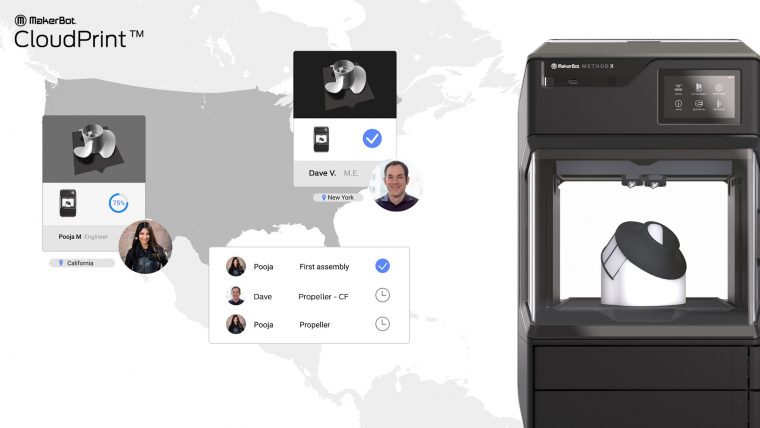 New MakerBot CloudPrint is Designed to Deliver a Seamless 3D Printing Experience for Teams Remote or Onsite
New MakerBot CloudPrint is Designed to Deliver a Seamless 3D Printing Experience for Teams Remote or Onsite
Users Can Prepare, Queue, Print, Monitor, and Manage 3D Print Jobs from a Centralized Cloud-Based Application
MakerBot, a global leader in 3D printing and subsidiary of Stratasys (Nasdaq: SSYS), today announces the new MakerBot CloudPrint™ software, designed to provide a seamless 3D printing workflow for teams to collaborate around the world.
With more people working remotely, there is a greater need for teams to manage their 3D printers and print jobs from anywhere. MakerBot CloudPrint (formerly MakerBot Cloud™) is the next-generation cloud-based 3D printing platform that enables individuals and teams to utilize 3D printing collaboratively, all from within their browser and across multiple devices. MakerBot CloudPrint combines the ease of use and familiar software features from MakerBot Print™ with the scalability of the cloud to provide a more efficient 3D printing workflow management solution. MakerBot CloudPrint is currently offered free to use, and is planned to be updated in the future to ensure users have access to the latest features.
“We are experiencing a global phenomenon with more people working remotely than ever before. Without the right tools, this can lead to a disruption in work and, ultimately, a decrease in performance,” said Nadav Goshen, CEO, MakerBot. “We believe that MakerBot CloudPrint is an ideal solution for individual or team collaboration from anywhere. MakerBot CloudPrint offers an all-in-one solution for users to prepare, queue, print, and manage printers. MakerBot CloudPrint aims to easily adapt to your workflow, no matter how many printers you have. This solution was built with productivity in mind, and we plan to continuously improve the fastest CAD-to-part benefits of the METHOD platform.”
The new workflow software has been designed to overcome common challenges associated with 3D printing, such as optimizing utilization, managing print jobs, and collaborating with team members. MakerBot CloudPrint provides a faster and more advanced print preparation and management solution to enable users to be more productive. The solution gives users more visibility into and control over their print jobs, from mass production to team projects to individually queued jobs. MakerBot CloudPrint allows users to prioritize print jobs by project or reorder the print queue based on shifting priorities. With MakerBot CloudPrint, teams can easily share access to connected MakerBot® 3D printers even when working remotely. MakerBot CloudPrint is also integrated with Google products, allowing users to access MakerBot applications with familiar tools.
“Working remotely has meant a lot of changes to how we collaborate in a creative environment. While many digital tools have replaced face to face interactions, nothing can replace working with physical prototypes. MakerBot CloudPrint enables us to work with our 3D printers at a distance, removing one more barrier in the process,” said Marco Perry, CEO, PENSA. PENSA is an industrial design and invention consulting firm based in New York City. The firm uses the MakerBot METHOD™ platform for a wide range of uses in its product design and development processes.
MakerBot CloudPrint streamlines the 3D printing workflow, improving productivity while reducing printer downtime between projects. Key features include:
Print preparation: Users can slice and prepare their 3D prints directly from their browser. The new full-featured print preparation view allows for easy part positioning and preview. Users can utilize optimized print modes for a seamlessly controlled experience or access advanced settings on the MakerBot METHOD platform, such as custom or experimental print profiles. The live camera feeds also provide the latest status updates on print jobs from connected printers.
Printer management: Users can add, monitor, and control access to connected MakerBot printers from anywhere. The dashboard provides a centralized location to track and view prints directly from a browser. Users can also generate reports to analyze the performance of their printers.
Queuing: The new printer queuing feature improves the productivity of the machines by queuing print jobs to each connected machine. Users can gain insights into their print jobs and track their projects using the queue and print history features.
Collaboration: Printers can be grouped into workspaces and shared with teams, production areas, or classrooms to reduce the hassles and redundancies of multiple printer management. Permissions can be set for team members to allow for better control and access to the workspace. Submission links can be created to allow anyone to submit print jobs for approval.
Advanced METHOD platform settings: MakerBot CloudPrint unlocks expert settings on the METHOD platform for users who need more advanced print features. This includes additional MakerBot LABS™ for METHOD user settings, custom print profiles, and access to the full portfolio of METHOD extruders and materials, including single extrusion feature to increase print volume, and more.
The MakerBot CloudPrint software is compatible with MakerBot’s 3D printing solutions, including the MakerBot METHOD 3D printer series, the MakerBot SKETCH Classroom™ bundle, and the MakerBot Replicator® 3D printer series. Additional MakerBot CloudPrint updates include speed optimizations, print performance improvements, new UX/UI designs, improved slicing and previewing options, and multi-model support.
MakerBot plans to release additional features for MakerBot CloudPrint in the near future, including improved print job queuing and organization, custom print modes, per layer preview improvements, and improved printer monitoring.
www.makerbot.com





























































































